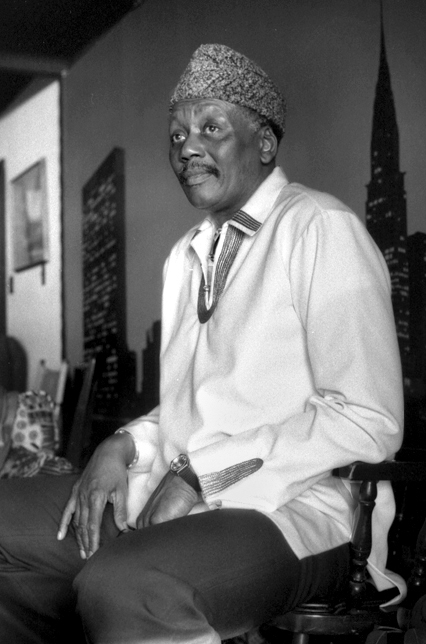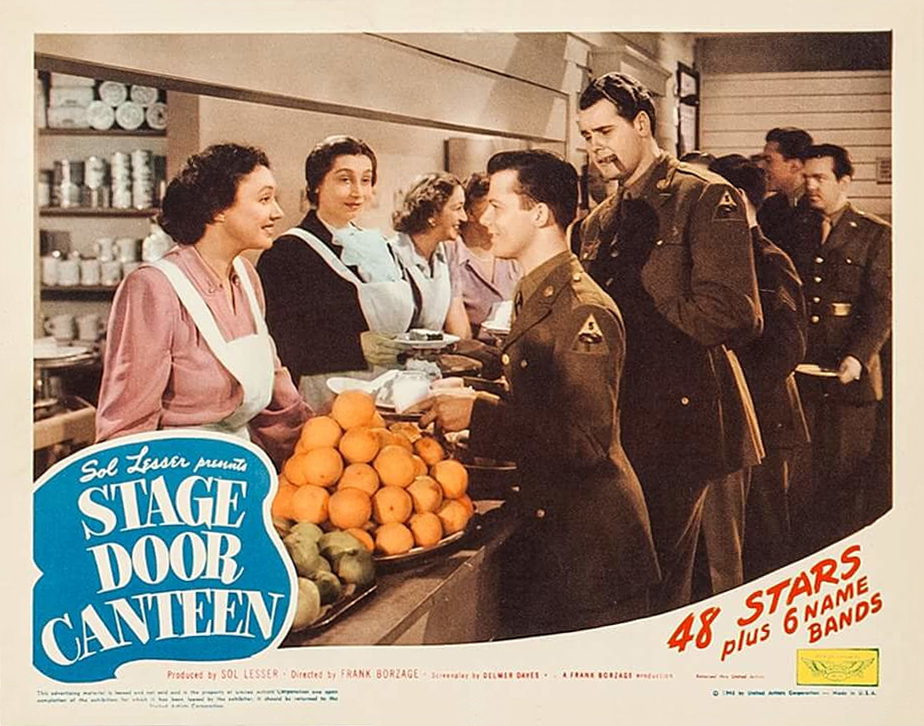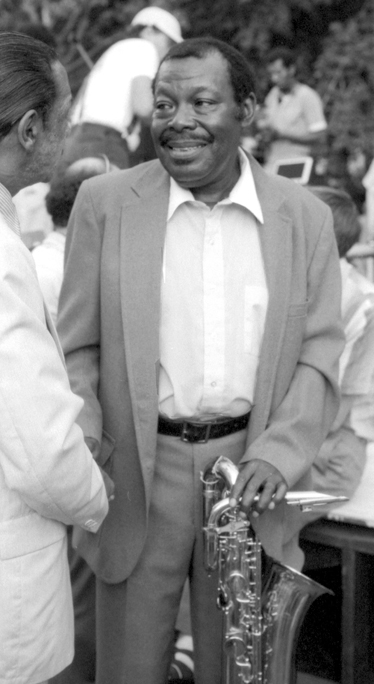|
The Modern Art Of Jazz By Randy Weston
''The Modern Art of Jazz by Randy Weston'' (also released as ''How High the Moon'') is a jazz album by American pianist Randy Weston recorded in 1956 and released on the Dawn label. Reception Allmusic awarded the album 3 stars, with the review by Scott Yanow stating: "This album does not deserve its obscurity".Yanow, SAllmusic review accessed August 10, 2012. The All About Jazz review said that "Randy Weston fans should certainly find this album a valuable peek at an early stage of his career".Roberts, JRandy Weston: How High the Moon review ''All About Jazz'', January 1, 1998. Track listing ''All compositions by Randy Weston except as indicated'' # "Loose Wig" - 3:01 # "Run Joe" (Louis Jordan, Walter Merrick, Joe Willoughby) - 3:43 # "A Theme for Teddy" - 5:41 # " In a Little Spanish Town" (Sam M. Lewis, Mabel Wayne, Joe Young) - 3:01 # " Don't Blame Me" (Dorothy Fields, Jimmy McHugh) - 5:18 # "J. K. Blues" - 4:17 # "Well, You Needn't" (Thelonious Monk) - 5: ... [...More Info...] [...Related Items...] OR: [Wikipedia] [Google] [Baidu] |
Randy Weston
Randolph Edward "Randy" Weston (April 6, 1926 – September 1, 2018) was an American jazz pianist and composer whose creativity was inspired by his ancestral African connection. Weston's piano style owed much to Duke Ellington and Thelonious Monk, whom he cited in a 2018 video as among pianists he counted as influences, as well as Count Basie, Nat King Cole and Earl Hines."Randy Weston talks about his new solo double CD Sound" YouTube video, March 27, 2018. Beginning in the 1950s, Weston worked often with trombonist and arranger Melba Liston. Described as "America's African Musical Ambassador", Weston once said: "What I do I do because it's about teaching and informing everyone about our most natural cultural phenomenon. It's really about Africa a ... [...More Info...] [...Related Items...] OR: [Wikipedia] [Google] [Baidu] |
Dorothy Fields
Dorothy Fields (July 15, 1904 – March 28, 1974) was an American librettist and lyricist. She wrote over 400 songs for Broadway musicals and films. Her best-known pieces include "The Way You Look Tonight" (1936), "A Fine Romance" (1936), "On the Sunny Side of the Street" (1930), " Don't Blame Me" (1948), "Pick Yourself Up" (1936), "I'm in the Mood for Love" (1935), "You Couldn't Be Cuter" (1938) and " Big Spender" (1966). Throughout her career, she collaborated with various influential figures in the American musical theater, including Jerome Kern, Cy Coleman, Irving Berlin, and Jimmy McHugh. Along with Ann Ronell, Dana Suesse, Bernice Petkere, and Kay Swift, she was one of the first successful Tin Pan Alley and Hollywood female songwriters. Early life Fields was born in Allenhurst, New Jersey, and grew up in New York City. In 1923, Fields graduated from the Benjamin School for Girls in New York City. At school, she was outstanding in the subjects of English, drama, and baske ... [...More Info...] [...Related Items...] OR: [Wikipedia] [Google] [Baidu] |
Cecil Payne
Cecil Payne (December 14, 1922 – November 27, 2007) was an American jazz baritone saxophonist born in Brooklyn, New York. Payne also played the alto saxophone and flute. He played with other prominent jazz musicians, in particular Dizzy Gillespie and Randy Weston, in addition to his solo work as bandleader. Biography Payne received his first saxophone aged 13, asking his father for the instrument after hearing " Honeysuckle Rose" performed by Count Basie with Lester Young soloing. Payne took lessons from a local alto sax player, Pete Brown, and studied at Boys High School, Bedford-Stuyvesant. Payne began his professional recording career with J. J. Johnson on the Savoy label in 1946. During that year he also began playing with Roy Eldridge, through whom he met Dizzy Gillespie. His earlier recordings would largely fall under the swing category, until Gillespie hired him. Payne stayed on board until 1949, heard performing solos on "Ow!" and "Stay On It". In the early 1950s, h ... [...More Info...] [...Related Items...] OR: [Wikipedia] [Google] [Baidu] |
Trumpet
The trumpet is a brass instrument commonly used in classical and jazz ensembles. The trumpet group ranges from the piccolo trumpet—with the highest register in the brass family—to the bass trumpet, pitched one octave below the standard B or C trumpet. Trumpet-like instruments have historically been used as signaling devices in battle or hunting, with examples dating back to at least 1500 BC. They began to be used as musical instruments only in the late 14th or early 15th century. Trumpets are used in art music styles, for instance in orchestras, concert bands, and jazz ensembles, as well as in popular music. They are played by blowing air through nearly-closed lips (called the player's embouchure), producing a "buzzing" sound that starts a standing wave vibration in the air column inside the instrument. Since the late 15th century, trumpets have primarily been constructed of brass tubing, usually bent twice into a rounded rectangular shape. There are many distinc ... [...More Info...] [...Related Items...] OR: [Wikipedia] [Google] [Baidu] |
Ray Copeland (musician)
Ray Copeland (July 17, 1926 – May 18, 1984) was an American jazz trumpet player and teacher. Early life Copeland was born in Norfolk, Virginia. He studied at Boys High School in the Bedford–Stuyvesant neighborhood of Brooklyn. Duke University Press Books, 2010, p. 71. Career Copeland's active career spanned from the 1940s to the 1980s. Throughout his career he participated on many swing and ...[...More Info...] [...Related Items...] OR: [Wikipedia] [Google] [Baidu] |
Piano
The piano is a stringed keyboard instrument in which the strings are struck by wooden hammers that are coated with a softer material (modern hammers are covered with dense wool felt; some early pianos used leather). It is played using a keyboard, which is a row of keys (small levers) that the performer presses down or strikes with the fingers and thumbs of both hands to cause the hammers to strike the strings. It was invented in Italy by Bartolomeo Cristofori around the year 1700. Description The word "piano" is a shortened form of ''pianoforte'', the Italian term for the early 1700s versions of the instrument, which in turn derives from ''clavicembalo col piano e forte'' (key cimbalom with quiet and loud)Pollens (1995, 238) and ''fortepiano''. The Italian musical terms ''piano'' and ''forte'' indicate "soft" and "loud" respectively, in this context referring to the variations in volume (i.e., loudness) produced in response to a pianist's touch or pressure on the keys: the grea ... [...More Info...] [...Related Items...] OR: [Wikipedia] [Google] [Baidu] |
Ted Koehler
Ted L. Koehler (July 14, 1894 – January 17, 1973) was an American lyricist. He was inducted into the Songwriters Hall of Fame in 1972. Life and career Koehler was born in 1894 in Washington, D.C. He started out as a photo-engraver, but was attracted to the music business, where he started out as a theater pianist for silent films. He moved on to write for vaudeville and Broadway theatre, and he also produced nightclub shows. His most successful collaboration was with the composer Harold Arlen, with whom he wrote many famous songs from the 1920s through the 1940s. In 1929 the duo composed their first well-known song, " Get Happy", and went on to create "Let's Fall in Love", " Stormy Weather", " Sing My Heart" and other hit songs. Throughout the early and mid-1930s they wrote for the Cotton Club, a popular Harlem night club, for big band jazz legend Duke Ellington and other top performers, as well as for Broadway musicals and Hollywood films. Koehler also worked with ot ... [...More Info...] [...Related Items...] OR: [Wikipedia] [Google] [Baidu] |
Harold Arlen
Harold Arlen (born Hyman Arluck; February 15, 1905 – April 23, 1986) was an American composer of popular music, who composed over 500 songs, a number of which have become known worldwide. In addition to composing the songs for the 1939 film '' The Wizard of Oz'' (lyrics by Yip Harburg), including " Over the Rainbow", Arlen is a highly regarded contributor to the Great American Songbook. "Over the Rainbow" was voted the 20th century's No. 1 song by the RIAA and the NEA. Life and career Arlen was born in Buffalo, New York, the child of a Jewish cantor. His twin brother died the next day. He learned to play the piano as a youth, and formed a band as a young man. He achieved some local success as a pianist and singer before moving to New York City in his early twenties, where he worked as an accompanist in vaudeville and changed his name to Harold Arlen. Between 1926 and about 1934, Arlen appeared occasionally as a band vocalist on records by The Buffalodians, Red Nichols, Joe ... [...More Info...] [...Related Items...] OR: [Wikipedia] [Google] [Baidu] |
Stormy Weather (song)
"Stormy Weather" is a 1933 torch song written by Harold Arlen and Ted Koehler. Ethel Waters first sang it at The Cotton Club night club in Harlem in 1933 and recorded it that year, and in the same year it was sung in London by Elisabeth Welch and recorded by Frances Langford. Also in 1933, for the first time the entire floor revue from Harlem's Cotton Club went on tour, playing theatres in principal cities. The revue was originally called ''The Cotton Club Parade of 1933'' but for the road tour it was changed to ''Stormy Weather Revue''; it contained the song "Stormy Weather", which was sung by Adelaide Hall. In September 1933, the group Comedian Harmonists released their German cover version, titled "''Ohne Dich''" ("Without You") with lyrics that are quite different. The song has since been performed by Frank Sinatra, Judy Garland, Etta James, Ella Fitzgerald, Dinah Washington, Clodagh Rodgers, Reigning Sound, Lena Horne, Billie Holiday, The Spaniels and others. Leo Reisman's o ... [...More Info...] [...Related Items...] OR: [Wikipedia] [Google] [Baidu] |
Morgan Lewis (songwriter)
William Morgan "Buddy" Lewis, Jr. (26 December 1906 – 8 December 1968) was a writer of jazz songs, some of which were also recorded in the pop music genre. Lewis was born in Rockville, Connecticut and died in New York City. He wrote songs and Broadway theatre scores with lyricist Nancy Hamilton including "How High the Moon" and "The Old Soft Shoe". Selected work ;Songs * "At Last It's Love" * "Cause You Won't Play House" * "Fool for Luck" * "A House with a Little Red Barn" * "How High the Moon "How High the Moon" is a jazz standard with lyrics by Nancy Hamilton and music by Morgan Lewis. It was first featured in the 1940 Broadway revue '' Two for the Show'', where it was sung by Alfred Drake and Frances Comstock. In ''Two for the S ..." * "I Only Know" * "If It's Love" * "A Lovely, Lazy Kind of Day" * "Oh, You're a Wonderful Person" * "The Old Soft Shoe" * "Teeter Totter Tessie" * "Two Can Dream the Same Dream" * "The Yoo Hoo Blues" ;Broadway theatre scores * ''New Face ... [...More Info...] [...Related Items...] OR: [Wikipedia] [Google] [Baidu] |
Nancy Hamilton
Nancy Hamilton (July 27, 1908 - February 18, 1985) was an American actress, playwright, lyricist, director and producer. Early life and education Nancy Hamilton was born in Sewickley, Pennsylvania on July 27, 1908, daughter of Charles Lee Hamilton and Margaret Miller Marshall. She was educated at Miss Dickinson's School in Sewickley, at the Sorbonne, and received a B.A. from Smith College in 1930. At Smith, Hamilton was active in the theater and was president of the school's Dramatic Association her senior year. She caused a bit of a scandal at the college with ''And So On'', a topical revue that she wrote and directed. Billy J. Harbin, Kim Marra and Robert A. Schanke, in their book ''The Gay & Lesbian Theatrical Legacy: A Biographical Dictionary of Major Figures in American Stage History in the Pre-Stonewall Era'', wrote "She amiltonhad received special permission from the president of this women's college to hire men to play in the show's orchestra. On opening night the audie ... [...More Info...] [...Related Items...] OR: [Wikipedia] [Google] [Baidu] |
How High The Moon
"How High the Moon" is a jazz standard with lyrics by Nancy Hamilton and music by Morgan Lewis. It was first featured in the 1940 Broadway revue '' Two for the Show'', where it was sung by Alfred Drake and Frances Comstock. In ''Two for the Show'', this was a rare serious moment in an otherwise humorous revue. Recordings The earliest recorded hit version was by Benny Goodman & His Orchestra, featuring vocalist Helen Forrest. It was recorded on February 7, 1940, and released by Columbia Records as catalog number 35391, with the flip side "Fable of the Rose". The Les Paul Trio recorded a version released as V-Disc 540B with a spoken introduction which was issued in November, 1945 by the U.S. War Department. In 1948, bandleader Stan Kenton enjoyed some success with his version of the tune. The recording, with a vocal by June Christy, was released by Capitol Records as catalog number 911 (with the flip side " Willow, Weep for Me") and 15117 (with the flip side "Interlude"). It re ... [...More Info...] [...Related Items...] OR: [Wikipedia] [Google] [Baidu] |





